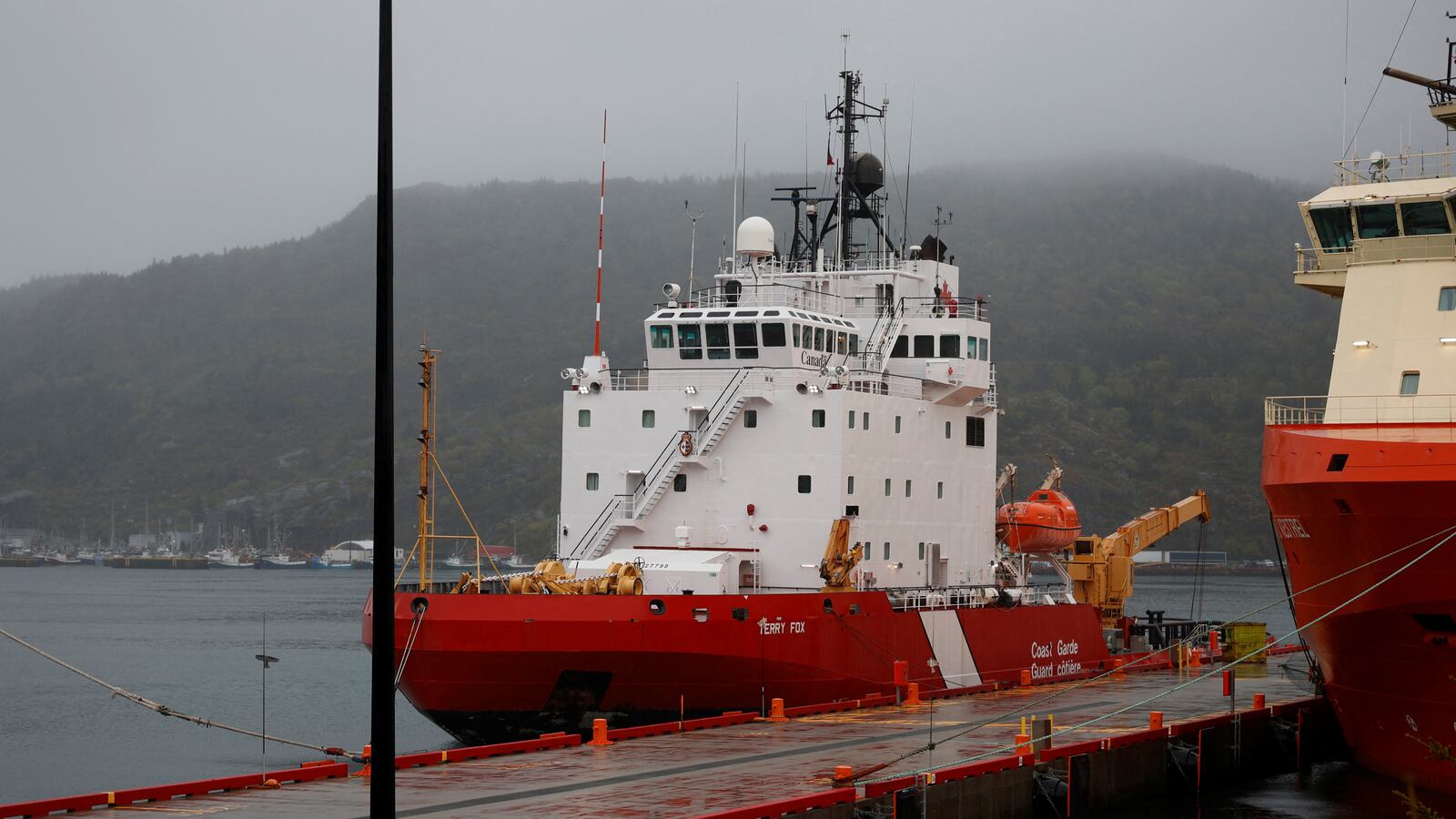The desperate search for the submersible that disappeared during a trip to the wreck of the Titanic reached a grim milestone Thursday morning as the point at which the vessel’s supply of oxygen was projected to run out came to pass.
The Titan submersible, which began its doomed descent on Sunday, was designed to offer a life support system of “96 hours for 5 crew,” according to the OceanGate Expeditions website. It’s possible that the passengers on board the vessel took action to reduce their oxygen consumption, potentially extending the timeframe for their rescue, but a U.S. Coast Guard spokeswoman told NBC News on Wednesday that the oxygen was forecast to have been used up by 7:08 a.m. ET on Thursday.
It’s not yet clear if the crew is considered lost even as new specialized vessels and equipment arrived at the vast active search area in the Atlantic Ocean.
Surveying the situation on Thursday, a retired Royal Navy officer said the outlook was “very gloomy indeed” and that we must “prepare ourselves for the worst.”
“I’m afraid to say that even if we were to find Titan now, the time it would take to get down there, secure them, bring them up... It’s vanishingly small in terms of the likelihood of survival,” Chris Parry told Sky News.
At 7:30 a.m. ET Thursday, a French-owned, advanced remote-operated craft called the Victor 6000 arrived on scene and was deployed into the water, the U.S. Coast Guard said. The Canadian vessel Horizon Arctic’s remote-operated vehicle also reached the sea floor and began its search for the missing sub at around the time same time.
The Victor 6000 is capable of reaching depths of up to 20,000 feet—deeper than anything else previously involved in the search effort—but experts suggested that Titan would probably already have to have been located for the new asset to make a difference before the oxygen window expired.
An unconfirmed report on Thursday suggested two vehicles had already been lost during the search as they attempted to dive lower than the 9,800-foot limit for which they were designed.
People involved in the mission have also not publicly disclosed if the 22-foot Titan is believed to be on the surface, somewhere in the middle of the water column, or trapped 12,500 feet down, the depth of the Titanic wreck. Rescuers have confirmed that “banging noises” have been detected in the roughly 10,000-square-mile search area and that those noises were heard on both Tuesday and Wednesday, but experts are not sure what the sounds are.
Speaking to Sky News on Thursday, Rear Adm. John Mauger of the U.S. Coast Guard said he still considers the mission an “active search and rescue at this point.” “We’re using the equipment that we have on the bottom right now—the remote-operated vehicles—to expand our search capability and then also to provide rescue capability as well.”
OceanGate co-founder Guillermo Sohnlein released a statement Thursday expressing his personal opinion that there could still be time to save the crew piloted by his friend and OceanGate CEO Stockton Rush. “Today will be a critical day in this search and rescue mission, as the sub’s life support supplies are starting to run low,” the statement read.
“I’m certain that Stockton and the rest of the crew realized days ago that the best thing they can do to ensure their rescue is to extend the limits of those supplies by relaxing as much as possible. I firmly believe that the time window available for their rescue is longer than what most people think.”
Sohnlein encouraged “everyone to remain hopeful” and said he continues “to hold out hope for my friend and the rest of the crew.”
The rest of the crew of Titan have been confirmed as Hamish Harding, a British billionaire, along with Pakistani businessman Shahzada Dawood and his teenage son, Suleman. French Titanic expert Paul-Henri Nargeolet is also on board.
U.S. Coast Guard Capt. Jamie Frederick said Wednesday that search teams “have to remain optimistic and hopeful” and discussed the possibility of the mission pivoting to assume that the crew has been lost. “There are a lot of factors you have to consider. After considering all those factors, sometimes you’re in a position where you have to make a tough decision,” he said. “We’re not there yet.”
He also said that eventuality would be discussed with the crew’s families “long before” it was revealed publicly.
Some experts have hoped that the professional experience of Nargeolet, a veteran of the French Navy who has taken part in dozens of previous dives to the Titanic, would have been useful to the crew in maximizing their chances of survival. Moving as little as possible could help to conserve oxygen, for example.
But the terror of the situation in which the crew found themselves, if indeed they have spent the past several days still conscious while trapped in the craft, could itself foreshorten their supply of breathable air. A deep-water rescue expert previously told The Daily Beast that rising anxiety leads to an increased breathing rate, in turn causing a faster depletion of oxygen.
Even in the event of the Titan having returned to the surface, the craft’s particular design and safety provisions—which have come under intense scrutiny this week—mean oxygen supply is still a concern. The hatch is bolted shut from the outside, such that the crew would have no way of opening it themselves.
If, however, the submersible is stuck at the depths of the Titanic, the temperature is also a factor affecting the chances of the crew’s survival. Nargeolet previously said the cold would be “the real problem” if a submersible became trapped at the wreck. “After a while, you die because of the cold, which is not a bad way to die because you fall asleep and you don’t suffer, in this case,” he said.
There are other disturbing scenarios that may have explained Titan’s loss of contact. “If there was any kind of hull breach, the occupants would succumb to the ocean in a near instant, given the more than 5,500 pounds per square inch [PSI] pressure exerted by the ocean at the depth of 3,800m, which is 380 times the air pressure at the surface,” said Nicolai Roterman, a deep-sea ecologist and lecturer in marine biology at the University of Portsmouth in the U.K.
“Another equally unpleasant possibility is fire,” Roterman added. “The air in deep-sea submersibles can be enriched in oxygen, which could increase the risk and intensity of fire. Often petroleum-based makeup and skin creams are prohibited in deep-sea dives owing to the fire risk. Even without oxygen enrichment, any fire would incapacitate the occupants quickly in such a confined space.”








